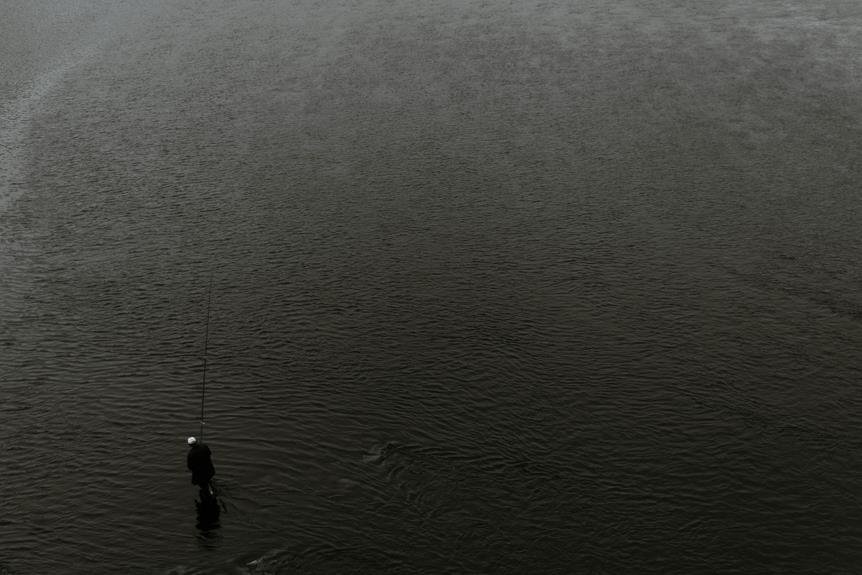Mastering haul casting techniques is essential for anglers to overcome wind resistance and achieve accurate and powerful casts. The water haul casting technique requires a nuanced understanding of the interplay between the fly line's tension, the rod's load, and the wind's resistance. Synchronizing the back cast and forward cast harnesses the wind's resistance, propelling the line forward with increased velocity. By refining haul casting techniques, anglers can achieve longer distances, higher speeds, and accurate presentations, even in windy conditions. Further exploration of haul casting techniques can reveal the secrets to mastering the art of fly casting.
Key Takeaways
- Mastering haul casting techniques requires a nuanced understanding of the interplay between the fly line's tension, the rod's load, and the wind's resistance.
- Haul casting enables anglers to overcome wind resistance and achieve precise presentations, making it ideal for windy conditions.
- The double haul technique is particularly effective in windy conditions, as it generates high line speed and maintains a tight casting form.
- The triple-haul cast is an advanced extension of the double haul, leveraging an additional haul back to further accelerate line speed and abruptly turn over the fly line.
- Refining haul casting techniques through deliberate practice and adjusting to conditions is essential for achieving success on the water.
Mastering Water Haul Casting
Employing the water haul casting technique effectively requires a nuanced understanding of the interplay between the fly line's tension, the rod's load, and the wind's resistance. Mastering this technique demands precise fly line management, as the line's tension and the rod's load must be harmoniously balanced to generate maximum power and speed. A smooth casting rhythm is essential, as it allows the angler to efficiently transfer energy from the rod to the line. By synchronizing the back cast and forward cast, the angler can harness the wind's resistance to propel the line forward with increased velocity. With practice, the water haul casting technique can become a powerful tool in the angler's arsenal, enabling them to cast with precision and confidence in windy conditions.
Double Haul Fly Fishing Technique
Building on the principles of water haul casting, the double haul fly fishing technique takes the concept of harnessing wind resistance to the next level, incorporating powerful back and forward casts to achieve exceptional casting distances and accuracy. This technique is particularly effective in windy conditions, as it enables anglers to generate high line speed and maintain a tight casting form. By mastering the double haul, fly fishers can overcome wind resistance and achieve precise presentations.
To execute the double haul effectively, consider the following key factors:
- Fly Rod: Use a rod that can generate high line speed and withstand wind resistance.
- Line Speed: Focus on achieving a high line speed to cut through wind and maintain accuracy.
- Casting Form: Maintain a consistent and efficient casting form to generate power and control.
The Triple-Haul Cast Advantage
The triple-haul cast, an advanced extension of the double haul technique, leverages an additional haul back with the line hand to further accelerate line speed and abruptly turn over the fly line, thereby enhancing precision and accuracy in windy conditions. This technique enables anglers to overcome wind resistance and present the fly with precision, even in challenging wind conditions. The triple haul's additional haul back generates a Fly Line Snap, which propels the line forward with increased speed, allowing the fly to turn over abruptly and land on target. By mastering the triple haul, anglers can overcome the limitations imposed by wind resistance, ensuring accurate and precise presentations in demanding fishing conditions.
When to Use Haul Casting
In situations where wind resistance compromises casting accuracy, haul casting techniques can be effectively utilized to counteract the wind's impact. This is particularly vital in windy conditions where traditional casting strategies may fall short. To optimize haul casting, it is essential to understand when to employ these techniques.
- Wind Conditions: Haul casting is ideal for windy conditions, as it allows anglers to counteract wind resistance and maintain casting accuracy.
- Casting Strategies: Haul casting is a valuable addition to an angler's casting arsenal, providing a reliable strategy for overcoming wind-related challenges.
- Distance and Speed: Haul casting enables anglers to achieve longer distances and higher speeds, making it an excellent choice for windy conditions where traditional casting may struggle.
Casting Into the Wind
When casting into the wind, anglers must adapt their haul casting techniques to compensate for the added resistance, as even slight miscalculations can result in substantially reduced casting distances and accuracy. To overcome wind resistance, anglers must generate more power and speed in their casts. This can be achieved by using a more aggressive haul, increasing the load on the rod, and leveraging the weight of the fly line to propel the cast forward. Effective fly control is essential in windy conditions, as the fly must be presented accurately and delicately to the target. By mastering haul casting techniques specifically designed for windy conditions, anglers can overcome the challenges of casting into the wind and achieve greater casting distances and accuracy.
Adapting to Wind Directions
Wind direction plays a crucial role in haul casting, as anglers must adjust their techniques to compensate for varying wind strengths and directions. Adaptation is key to achieving accurate and effective casts. To master wind adaptation, anglers should consider the following:
- Identify wind direction: Determine the direction of the wind to adjust casting angle and technique.
- Adjust casting angle: Compensate for wind direction by adjusting the casting angle to facilitate precise presentations.
- Modify line speed: Adjust line speed to counteract wind resistance and maintain a straight line path.
Tips for Weighted Flies
Fly selection and weighted fly design substantially impact the effectiveness of haul casting techniques, particularly in windy conditions. When using weighted flies, you must choose patterns that can withstand the forces generated by haul casting. Fly patterns with a heavy bead or cone head are ideal, as they can cut through the wind and maintain a consistent trajectory.
| Fly Pattern | Weight | Sinking Line |
|---|---|---|
| Bead Head Nymph | Heavy | Fast Sinking |
| Cone Head Streamer | Medium | Intermediate Sinking |
| Weighted Leech | Light | Slow Sinking |
| Heavy Stonefly | Heavy | Fast Sinking |
| Weighted Woolly Bugger | Medium | Intermediate Sinking |
When using weighted flies, you must choose patterns that can withstand the forces generated by haul casting.
Double Haul Short Distances
In situations where accuracy and precision are paramount, the double haul technique can be adapted for short distances, enabling anglers to present flies with precision and control. When targeting fish in close proximity, a short rod and compact loop are essential for making accurate presentations. To achieve this, anglers must employ a fast tempo and quick pickup to minimize the amount of line in the air, reducing the risk of spooking the fish.
Three key considerations for adapting the double haul for short distances:
- Short leaders: Leaders should be kept short to minimize drag and maintain a direct connection to the fly.
- Compact loops: Compact loops are essential for accuracy and control when casting short distances.
- Fast tempo: A fast tempo is necessary to quickly pickup and present the fly, reducing the risk of spooking the fish.
Forward Cast Angles Matter
The trajectory of the forward cast, influenced by the angle of presentation, substantially impacts the accuracy and effectiveness of haul casting techniques. The forward cast angle determines the fly trajectory, which, in turn, affects the fly's interaction with wind resistance. A shallow angle results in a longer, more horizontal trajectory, increasing the fly's exposure to wind resistance and reducing accuracy. Conversely, a steeper angle produces a shorter, more vertical trajectory, minimizing wind resistance and enhancing accuracy. By adjusting the forward cast angle, anglers can optimize the fly's trajectory to counter wind resistance and achieve precise presentations. This nuanced understanding of forward cast angles is critical for mastering haul casting techniques in varying wind conditions.
Mastering Haul Casting Timing
Accurate timing is critical to mastering haul casting, as it enables anglers to generate the necessary power and speed to overcome wind resistance and achieve precise presentations. To achieve optimal timing, focus on the following key elements:
- Rod Balance: Ensure your rod is balanced and loaded evenly to generate maximum power and speed.
- Fly Loop: Monitor the shape and size of your fly loop to adjust your timing accordingly.
- Haul Speed: Coordinate your haul speed with the unfolding of the fly line to achieve a seamless, high-speed cast.
Practice for Success
A deliberate rehearsal regimen, tailored to your specific haul casting technique, is essential for developing the muscle memory and fine motor skills necessary to execute high-speed casts with precision. Mental Preparation is key to successful practice, as it allows you to focus on the intricacies of your technique and make adjustments accordingly. Consistency Matters, and a well-structured practice routine will help you develop a consistent casting stroke, enabling you to overcome wind resistance and accurately place your fly. By dedicating time to deliberate practice, you'll refine your haul casting technique, build confidence, and ultimately, achieve success on the water. Regular practice will also help you develop the necessary strength, flexibility, and coordination to execute powerful casts with precision and control.
Frequently Asked Questions
Can I Use Haul Casting Techniques With a Beginner's Fly Rod?
When selecting a rod for haul casting, consider a rod with a fast action and sufficient power to handle windy conditions; as a beginner, prioritize building casting confidence before shifting to haul casting techniques.
How Do I Avoid Tangles With the Haul Casting Technique?
To avoid tangles with haul casting, prioritize fly management by maintaining a organized coil, maintain line control through precise casting form, and optimize leader length to prevent knots, thereby minimizing tangles and guaranteeing a smooth presentation.
What Is the Ideal Wind Speed for Haul Casting Techniques?
As the wind whispers secrets to the fly fisherman, ideal wind speeds for haul casting techniques emerge: 10-20 mph, where wind resistance and air density converge, optimizing line turnover and precision in the face of turbulent air currents.
Can I Use Haul Casting With a Sinking Fly Line?
When using a sinking fly line, haul casting can be challenging due to increased line weight and sinking depths, requiring precise line control to maintain a consistent presentation and avoid line tangles.
Are Haul Casting Techniques Suitable for Saltwater Fly Fishing?
In the domain of saltwater fly fishing, where ocean currents and fish behavior necessitate precision, haul casting techniques can be advantageous, but must be adapted to overcome fly rod limitations and saltwater challenges, ensuring effective line management.
Conclusion
Finally, haul casting techniques are essential tools for fly fishermen seeking to overcome windy conditions. By mastering water haul, double haul, and triple-haul casts, anglers can generate increased velocity and accuracy. As the winds howl and waves crash, can one truly appreciate the precision and power of haul casting? By internalizing the intricacies of timing and coordination, anglers can tap the full potential of these techniques, transforming even the most turbulent environments into fertile fishing grounds.









